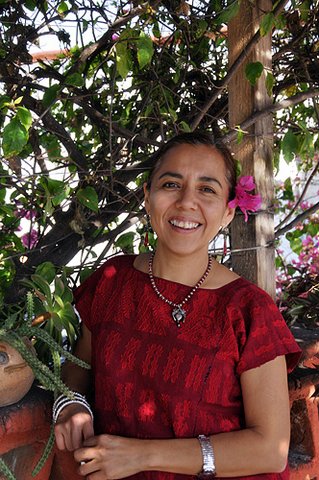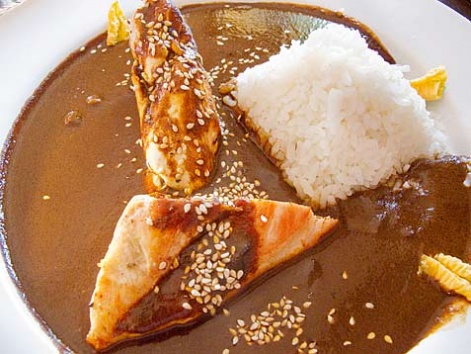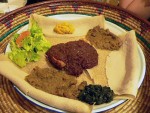 “I try to portray the colors of the Oaxacan landscape in the food I prepare: color, color, color! Oaxaca is such a vibrant place, and having this reflected in the food you eat here makes Oaxacan cuisine even more enjoyable.”—Chef Pilar Cabrera,
“I try to portray the colors of the Oaxacan landscape in the food I prepare: color, color, color! Oaxaca is such a vibrant place, and having this reflected in the food you eat here makes Oaxacan cuisine even more enjoyable.”—Chef Pilar Cabrera,
La Olla
Tell us about your job.
Currently I manage the kitchen of my restaurant La Olla, in Oaxaca, Mexico, and I am also the cooking instructor at Casa de los Sabores Cooking School.
What led you to become a chef?
I started cooking at an early age. My love for the smell, taste, color, and texture of food motivated me to go to university and get a degree in Food Engineering and Nutrition. After graduating I worked for Herdez-McCormick in the Development and Sensory Evaluation Department for four years, later moving back to Oaxaca to fulfill an even bigger dream: opening my own restaurant. In 1994 I opened La Olla, a restaurant that features what I believe to be the most important aspect of any restaurant: a healthy kitchen.
What’s your favorite part of your job?
I love to eat and to travel. I also thoroughly enjoy seeing other people appreciate my food, the food that I prepare and the ingredients and recipes that I put together. It makes me so happy to see the smiles on my clients’ faces when they try mole for the first time, or when they dig into a dish that I created. It’s a wonderful feeling!
We loved your mole negro and sopa de frijol at La Olla. How does your food speaks to the culinary landscape of Oaxaca?
I base my approach to food on an earth-friendly philosophy, working with regional farmers to provide local flavors while helping the local economy and serving organic products when available. I try to use as many local ingredients as possible, and I also try to portray the colors of the Oaxacan landscape in the food that I prepare: color, color, color! I try to make every dish a reflection of the colors of Oaxaca. Oaxaca is such a vibrant place, and having this reflected in the food you eat here makes Oaxacan cuisine even more enjoyable.

Are there any ingredients that you have trouble finding locally?
Chilhuacle chile is an ingredient that’s gaining popularity in and around Oaxaca, and it is sometimes difficult to find due to its high price. A lot of the chile salespeople refuse to sell this specific type of chile because it is too expensive for them to carry. Also, the different varieties of corn are getting harder and harder to find: red, purple, yellow. It would be nice to be able to use all of the different colors of corn in our dishes at the restaurant and cooking school, but it’s just not possible anymore.
Name some Oaxacan dishes that a visitor should not miss while in Oaxaca.
Tlayudas (giant corn tortillas topped with asiento, black beans, cheese, vegetables, grilled meat, and salsa), mole (different varieties), chiles rellenos (stuffed chiles), and mezcal (of course!).
What is your favorite place to eat in Oaxaca, other than your own restaurant?
The most expensive/popular restaurant is not always the best one, especially when dining in Mexico. Wherever they make fresh tortillas and use fresh ingredients, like most street food stands and in the markets—that’s where I like to eat.
Eat Your World focuses a lot on a city’s historic, traditional foods. What do you think is the future of food/drink in Oaxaca?
The future of food and drink in Oaxaca is actually quite a sad story: A lot of recipes are getting lost, and traditional ingredients are disappearing. Also, very few people are worried about conserving traditional recipes. For example, that chilhuacle chile, used in mole chichilo, is getting harder and harder to find. Therefore the recipe for this mole is changing because of the chile’s availability. More herbs and other chiles are being used instead of the chilhuacle, and this inevitably changes the taste and consistency of the mole. Globalization also plays a part—more supermarkets and less real mercados. And family traditions are changing: You used to go to work in the morning, go home in the afternoon for a few hours and eat a big lunch, and then return to work, but not anymore. There’s no time, so therefore recipes and traditions are getting lost.
On EYW, we ask users to share short food memories related to travel, a favorite meal, growing up—anything. Can you share a brief food memory with our readers?
My fondest memory is learning to make mole with my grandmother: no rules, no real recipes. Roasting the chiles, going to the mill, adding the chocolate and the salt—it’s not about the quantity but about the quality, and somehow the dishes always came out perfectly, with no measuring cups or teaspoons necessary....it just works. I’d have to say that is the best memory I have of growing up around traditional Oaxacan food. My grandmother’s mole—it always tasted the same, though she never used a recipe.
Check out La Olla and read more about Oaxacan foods and drinks on EYW here.
Got a suggestion of a food producer we should interview? Let us know!










.jpg)

